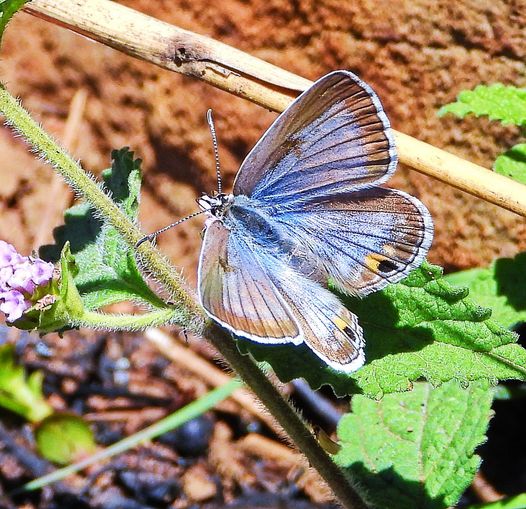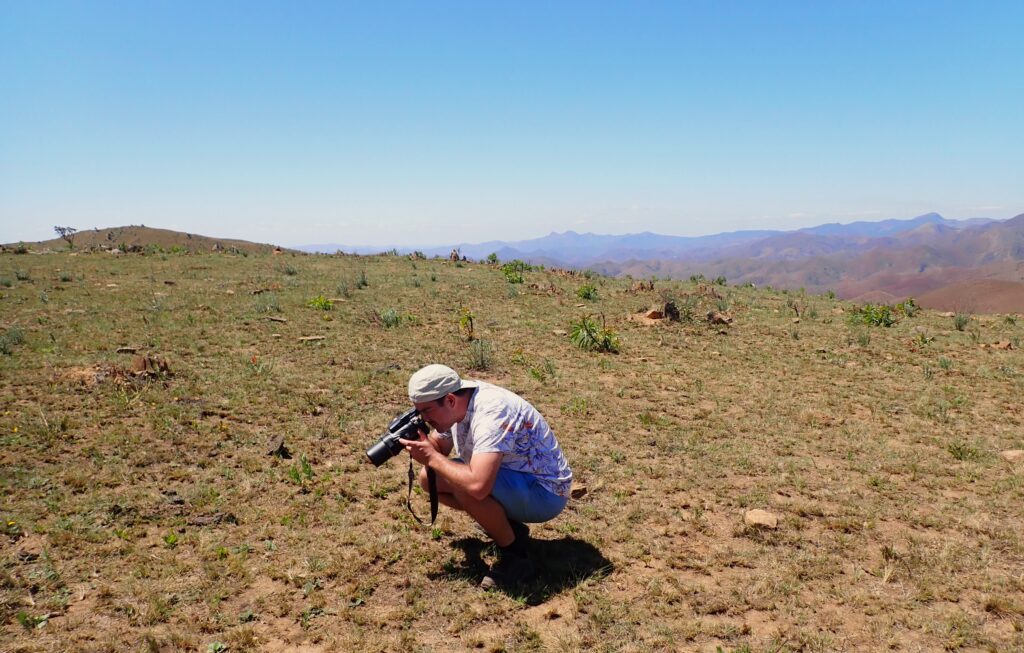
Lourens Erasmus in his element on Mountainlands.
I was invited by Michael Baine to conduct the Lepidopterist Society of Africa’s (Lepsoc for short) annual survey of Mountainlands Nature Reserve. Michael is the Lepsoc custodian for the endangered butterfly species Cloud Russet (Aloeides nubilus) and Barberton Russet( Aloeides barbarae).
The survey is part of ongoing research into the well-being of some of South Africa’s rarest and most localised butterflies, such as the endangered Barberton Russet (Aloeides barbarae) and Cloud Russet (Aloeides nubilus), the critically endangered Barberton Giant Cupid/Swanepoel’s Blue (Lepidochrysops swanepoelii), Purple Brown Giant Cupid/ Jeffery’s Blue (Lepidochrysops jefferyi), and Grassveld Russet(Aloeides swanepoeli).
On 5 October, I was accompanied by Sheena Kellerman and our lovely host, Delia Oosthuizen, who both contributed to a very successful trip. We managed to find all of our target species as well as adding a further 3 species to the 98 found from our previous survey in 2022 which was conducted by myself, Malcom Baine and Jeremy Dobson, bringing the list to 110 species to date.
The day started off with Delia meeting us at a reserve gate in a game drive vehicle which she explained would be necessary to reach our target location on top of the mountains. The roads were very steep and rocky and we had to navigate tight turns and bending roads, which Delia did with ease looking like a professional rally driver.
Our first significant find of the day was a stunning Saffron Sapphire (Iolaus pallene) which Sheena happened to point out as it was flying across the road and landed right next to us. At first, I thought it was some sort of buff, but it turned out to be the most beautiful, yellow butterfly in South Africa. I was overjoyed and filled with excitement as not only was this a property record, but also the realization of a dream that I had for 6 years. It was the first time I managed to photograph the species and all I can say is that God truly is a master artist. The markings and coloration of this butterfly is truly exquisite.
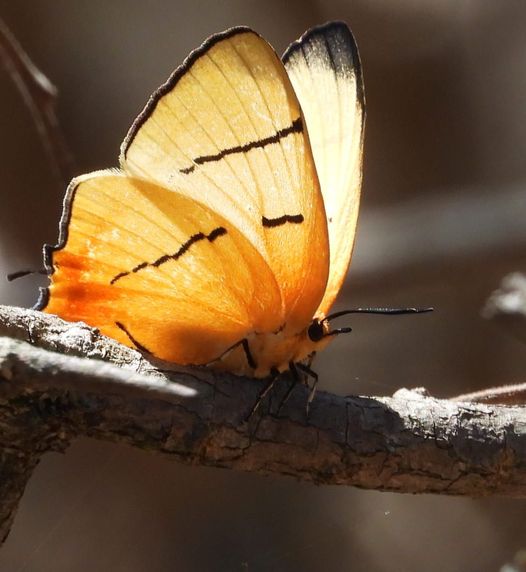
Saffron Sapphire. Photo by Lourens Erasmus.
As we made our way up the hills, Delia found a very fresh Veined Swordtail (Graphium leonidas) which had us all in awe as it posed beautifully with open wings and allowed me to get reasonably close to get some nice photographs. As we approached the top of the hills the Russets started to come out in good numbers.
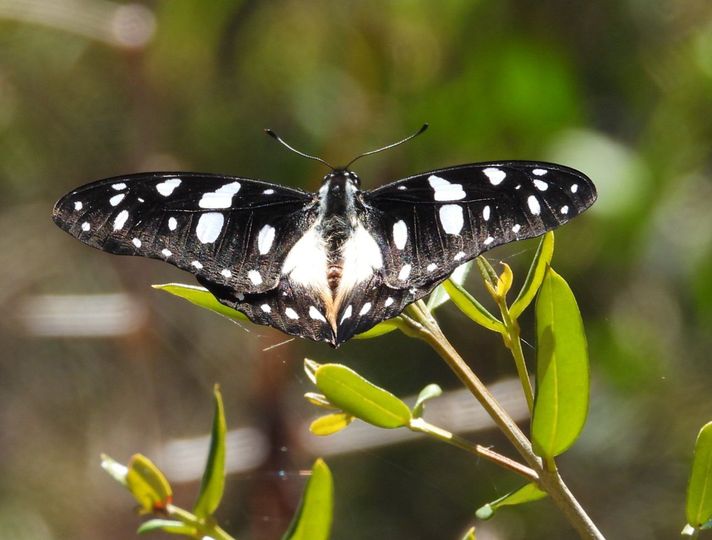
Veined Swordtail. Photo by Lourens Erasmus.
I am pleased to report that I saw at least 20 Grassveld Russets (Aloeides swanepoeli) which are critically endangered. I also saw at least 20 Transvaal Russets, a few Yellow/ Aranda Copper (Aloeides aranda), Barberton Russet (Aloeides barbarae) which is endangered, Henning’s Russets (Aloeides henningi) as well as a couple of what I think could be Clouded Russets (Aloeides nubilus) which are also endangered.
I also finally understood the hype behind the Barberton Giant Cupid/Swanepoel’s Blue (Lepidochrysops swanepoelii) as I managed to find one flying right next to an isolated clump of rocks on top of the hill. Seeing this butterfly land with open wings was a real treat and a moment I’m glad to have shared with Delia and Sheena as I’m sure they would agree the unique silvery powder blue sheen is enough to bring a smile to anyone’s face. To my great surprise, we also managed to record a female ovipositing on Lantana rugosa which is a new type of host plant for this butterfly. It was previously only know to lay eggs on Ocimum obovatum. This is significant as it allows the caterpillars to feed on a new plant and thus enhance their chances to become beautiful butterflies themselves.
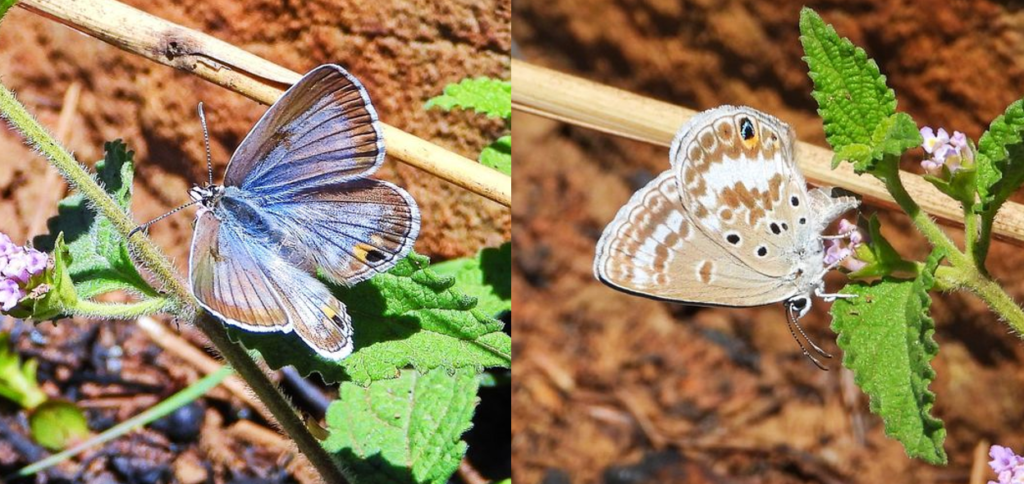
Barberton Giant Cupid on Lantana rugosa. Photos by Lourens Erasmus
In terms of numbers though they were rare as I only saw 6 individuals and two Purple Brown Cupids which were less willing to sit still for photographs and the ones I got were average at best.
I somehow managed to lose Sheena and Delia as my excitement got the better of me as I approached the original site from our previous visit two years ago. It was right at the top of the mountain and I managed to find two other property records. These were a lone Russet Protea (Capys disjunctus) which, despite having lots of Proteas to rest in, decided to rest inside a ditch which I found pretty strange. I also saw a beautiful Mozambique Silverline (Cigaritis mozambica) displaying its beautiful blue, yellow and black wings from all angles.
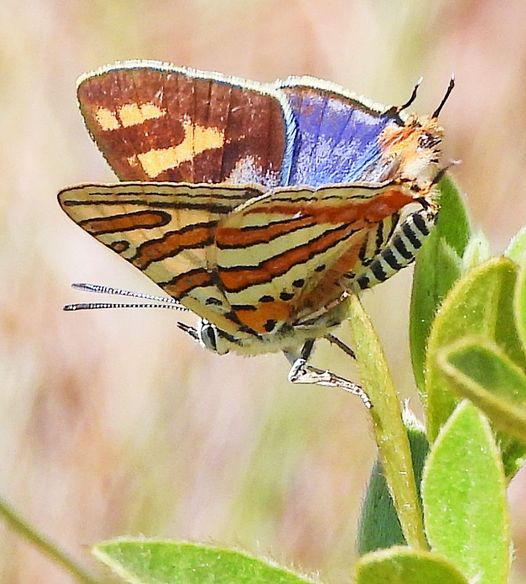
Mozambique Silverline. Photo by Lourens Erasmus
We managed to record a respectable 51 species between us, which considering how little rain the reserve had was a rather good total.
I had a wonderful time and felt really blessed to have had this opportunity to visit one of the most beautiful nature reserves and spend time with two very interesting ladies. I would like to thank Delia and Malcom for inviting me and making me a part of this research and I hope to be back in December as I am sure there are many more beautiful butterflies to discover in this magical nature reserve.

